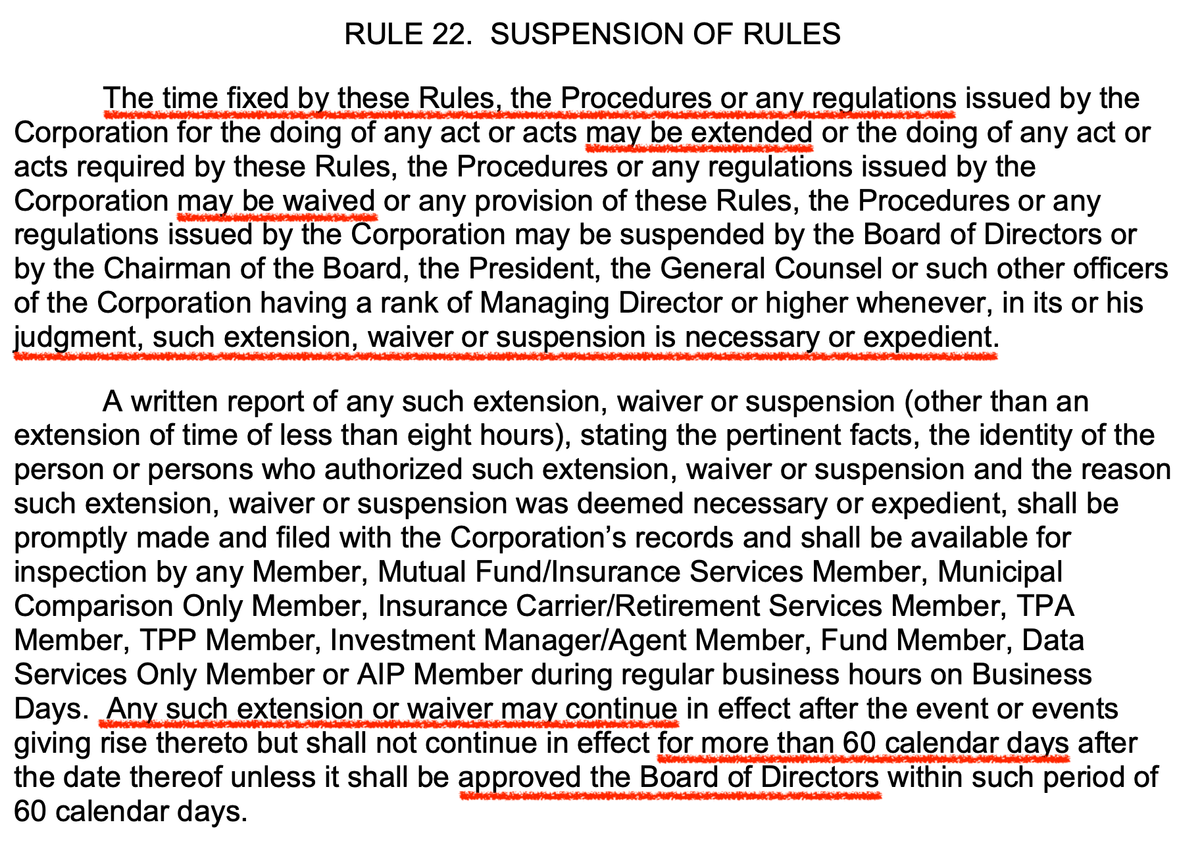FICC Alert! FICC approves rule change to Revise the Description of the Stressed Period Used to Calculate the Value-at-Risk Charge.
FICC represents that, in order to mitigate the increased risk exposures, FICC has to quickly and timely respond to rapidly changing market conditions.
Order Granting Proposed Rule Change to Revise the Description of the Stressed Period Used to Calculate the Value-at-Risk Charge and Make Other Changes

Source: https://www.sec.gov/rules/sro/ficc/2023/34-97342.pdf
BACKGROUND AND DESCRIPTION OF THE APPROVED RULE CHANGE:
- The Commission finds that the change to the description of the stressed period should help FICC to continue providing prompt and accurate clearance and settlement of securities transactions in the event of a member default, consistent with Section 17A(b)(3)(F) of the Act.
Moreover, in the event of a clearing member default, FICC would access the mutualized the Clearing Fund should a defaulted member’s own margin be insufficient to satisfy losses to FICC caused by the liquidation of that member’s portfolio.
- The implemented change to the description of the stressed period should help FICC collect sufficient margin from members, thereby limiting non-defaulting members’ exposure to mutualized losses in the event of a member default.
- The Commission believes that by helping to limit the exposure of FICC’s non-defaulting members to mutualized losses, the proposed changes should help FICC assure the safeguarding of securities and funds which are in its custody or control, consistent with Section 17A(b)(3)(F) of the Act.
- Section 17A(b)(3)(F) of the Act requires, in part, that the rules of a clearing agency be designed to, among other things, promote the prompt and accurate clearance and settlement of securities transactions and assure the safeguarding of securities and funds which are in the custody or control of the clearing agency or for which it is responsible.
- FICC operates two divisions: the Government Securities Division (“GSD”) and the Mortgage Backed Securities Division (“MBSD”). GSD provides trade comparison, netting, risk management, settlement, and central counterparty services for the U.S. Government securities market.
- MBSD provides the same services for the U.S. mortgage backed securities market. GSD and MBSD maintain separate sets of rules, margin models, and clearing funds.
- A key tool that FICC uses to manage its credit exposures to its members is the daily collection of margin from each member.
- A member’s margin is designed to mitigate potential losses associated with liquidation of the member’s portfolio in the event of that member’s default.
- The aggregated amount of all GSD and MBSD members’ margin constitutes the GSD Clearing Fund and MBSD Clearing Fund, which FICC would be able to access should a defaulted member’s own margin be insufficient to satisfy losses to FICC caused by the liquidation of that member’s portfolio.
- Each member’s margin consists of a number of applicable components, including a the valueat-risk (“VaR”) charge (“VaR Charge”) designed to capture the potential market price risk associated with the securities in a member’s portfolio.
- The VaR Charge is typically the largest component of a member’s margin requirement.
- The VaR Charge is designed to cover FICC’s projected liquidation losses with respect to a defaulted member’s portfolio at a 99% confidence level.
- FICC states that it has observed significant volatility in the U.S. government securities market due to tightening monetary policy, increasing inflation, and recession fears, and that this volatility has led to greater risk exposures for FICC.
FICC represents that, in order to mitigate the increased risk exposures, FICC has to quickly and timely respond to rapidly changing market conditions.
- For example, in order to respond to rapidly changing market conditions, FICC states that it may need to quickly adjust the look-back period that FICC uses for purposes of calculating the VaR Charge with an appropriate stressed period, as needed, to enable FICC to calculate and collect adequate margin from members.
- Accordingly, FICC is amending the GSD Quantitative Risk Management (“QRM”) Methodology Document – GSD Initial Market Risk Margin Model (“GSD QRM Methodology Document”) and the MBSD Methodology and Model Operations Document – MBSD Quantitative Risk Model (“MBSD QRM Methodology Document,” and collectively with the GSD QRM Methodology Document, the “QRM Methodology Documents”) to revise the description of the stressed period used to calculate the VaR Charge in order to help FICC quickly and timely adjust the look-back period used for calculating the VaR Charge with an appropriate stressed period, as needed.
- FICC states that adjustments to the look-back period could affect the amount of the VaR Charge that members are assessed by either increasing or decreasing such charge to reflect the level of risk the activities of the members presented to FICC.
- FICC is also amending the GSD QRM Methodology Document to clarify the language describing the parameters used to calculate the VaR Floor.
Revising the Description of the Stressed Period Used to Calculate the VaR Charge:
- FICC calculates VaR Charge by using a methodology referred to as the sensitivity approach. The sensitivity approach allows FICC to adjust the look-back period that FICC uses for purposes of calculating the VaR Charge.
- In particular, the sensitivity approach leverages external vendor data to incorporate a look-back period of 10 years, which allows the GSD and MBSD models to capture periods of historical volatility.
- In the event FICC observes that the 10-year look-back period does not contain a sufficient number of stressed market events, FICC will include an additional period of historically observed stressed market events to the 10-year look-back period.
The QRM Methodology Documents currently describe the additional stressed period as a configurable continuous period (typically one year).
- The GSD QRM Methodology Document further specifies the duration of the stressed period as one-year of stressed market events.
- FICC states that it regularly reviews metrics from various assessments to ensure the GSD and MBSD models are performing as designed.
In order to provide FICC with more flexibility with respect to the inclusion of sufficient number of stressed market events in the look-back period so FICC can respond to rapidly changing market conditions more quickly and timely, FICC is proposing to eliminate this detailed description of the stressed period from the GSD QRM Methodology Document (in Sections 2.10.1 (The list of key parameters) and A4.5.16.1 (Stressed VaR Calculation)), as well as the MBSD QRM Methodology Document (Section 5.17.1 (Stressed VaR Calculation)), and replace it with a more general description.
- Specifically, the proposed new description of the stressed period would provide in the GSD QRM Methodology Document (Section A4.5.16.1) and the MBSD QRM Methodology Document (Section 5.17.1) that the “stressed period” shall be a period of time that FICC may add, in its sole discretion, to the 10-year historical look-back period that includes stressed market events that are not otherwise captured in the look-back period.
- The proposed new description would also provide that a stressed period, if added to the look-back period, shall be no shorter than 6 months and no longer than 36 months, and comprised of either one continuous period specified by a start date and an end date or comprised of more than one non-continuous period.
- FICC states that it is currently contemplating changing the stressed period at GSD from one year to 1.5 years while keeping the current one-year stressed period at MBSD unchanged.
In addition, the proposed new description would provide that, when determining whether it is necessary to add a stressed period to the 10-year historical look-back period (and the appropriate length of an added stressed period), FICC would review all relevant information available to it at the time of such determination.
Including, for example:
- (1) the nature of the stressed market events in the current 10-year historical look-back period
- (2) backtesting coverage ratios, and
- (3) market volatility observed by FICC.
- Further, the proposed new description would provide that changes to the stressed period shall be approved through FICC’s model governance process set forth in the Clearing Agency Model Risk Management Framework (“Framework”), and any current stressed period shall be documented and published to FICC members at the time such stressed period becomes effective.
- FICC believes that having a more general description would enable FICC to adjust the stressed period more quickly and timely because the adjustment process, such as constructing a stressed period comprised of more than one year’s historical data that may not be continuous, would be more streamlined and not require a rule change.
- By being able to quickly and timely make adjustments to the stressed period, FICC states that it would have the flexibility to respond to rapidly changing market conditions more quickly and timely, which would, in turn, help better ensure that FICC calculates and collects adequate margin from members and risk manages its credit exposures to its members.
- The lookback period would continue to be tracked in the monthly model parameter report, pursuant to the QRM Methodology Documents, and any changes to the look-back period would continue to be subject to the internal model governance process of the Depository Trust and Clearing Corporation (“DTCC”), as described in the Framework.
- FICC conducted an impact study for the period from January 2021 to October 2022 (“Impact Study”), which reviewed the overall impact of the contemplated change to the stressed period (i.e., changing the current stressed period of one year (September 2008 to August 2009) to a stressed period of 1.5 years (January 2008 to June 2009) on the GSD VaR model backtesting coverage and VaR Charge amounts, as well as the effect on the GSD Members during the Impact Study period.
- The results of the Impact Study indicate that, if a stressed period of 1.5 years had been in place for GSD, the GSD’s rolling 12-month VaR model backtesting coverage ratio would have improved by 29 bps (from 98.52% to 98.81%) as of October 2022 and the associated VaR Charge increase for GSD would be approximately $387 million (or 2.1%) on average during that period.
- The Impact Study further indicated that the three GSD Members with the largest average daily VaR Charge increases in dollar amount during the Impact Study period would have had increases of approximately $43.7 million, $43.24 million, and $39.55 million, representing an average daily increase for such Members of 3.4%, 4.4%, and 2.8%, respectively.
- The three GSD Members with the largest average daily VaR Charge increases as a percentage of VaR Charges paid by such Members during the Impact Study period would have had an average daily increase of 16.6%, 15.7% and 12.7%, respectively, had the contemplated stressed period been in place.
- The three GSD Members with the largest average daily VaR Charge decreases in dollar amount during the Impact Study period would have had decreases of approximately $8.59 million, $7.93 million, and $7.24 million representing an average daily decrease for such Members of 4.3%, 1.3%, and 2.9%, respectively.
- The three GSD Members with the largest average daily VaR Charge decreases as a percentage of VaR Charges paid by such Members during the Impact Study period would have had an average daily decrease of 4.3%, 4.0% and 3.4%, respectively, had the contemplated stressed period been in place.
Clarifying the VaR Floor Parameter Language:
- The VaR Charge is subject to a minimum amount (the “VaR Floor”) that FICC employs as an alternative to the amount calculated by the VaR model for portfolios where the VaR Floor is greater than the model-based charge amount.
- A VaR Floor addresses the risk that the VaR model may calculate too low a VaR Charge for certain portfolios where the VaR model applies substantial risk offsets among long and short positions in different classes of securities that have a high degree of historical correlation.
- Because this high degree of historical price correlation may not apply in future changing market conditions, FICC applies a VaR Floor to protect FICC against such risk in the event that FICC is required to liquidate a large securities portfolio in stressed market conditions.
- VaR Floor at GSD is determined by multiplying the absolute value of the sum of the Net Long Positions and Net Short Positions of Eligible Securities, grouped by product and remaining maturity, by a percentage designated by FICC from time to time for such group.
Currently, the GSD Rules provide that for
- (i) U.S. Treasury and agency securities, such percentage shall be a fraction, no less than 10%, of the historical minimum volatility of a benchmark fixed income index (i.e., haircut rate) for such group by product and remaining maturity and
- (ii) mortgage-backed securities, such percentage shall be a fixed percentage that is no less than 0.05%.
- However, the GSD QRM Methodology Document specifies these percentages (referred to as floor parameters therein) for government bond and MBS Pool as simply 10% and 5 Bps, respectively.
- To avoid inconsistency with the GSD Rules, FICC is clarified changes to the floor parameter language in Section 2.10.1 of the GSD QRM Methodology Document.
- Specifically, FICC revised the description of the floor parameter for government bond by deleting the reference to 10% and adding language that state the parameter is a percentage as designated by FICC from time to time pursuant to the GSD Rules and applied to the haircut rate of the respective government bonds.
- Similarly, for the description of the floor parameter for MBS Pool, FICC is revised by deleting the reference to 5 Bps and adding language that state the parameter is a percentage as designated by FICC from time to time pursuant to the GSD Rules.
- In addition, FICC is added a sentence making it clear that the floor parameters are tracked in the monthly model parameter report and that any future changes to the floor parameters would be subject to DTCC’s internal model governance process set forth in the Framework.
- Lastly, consistent with the proposed changes to the floor parameters described above, FICC deleted from the GSD QRM Methodology Document the language in Sections 3.2.2 (Calculation of haircut of Treasury and Agency bonds without sensitivity analytics data) and 3.5 (Total VaR, Core Charge and Standalone VaR) that references the floor parameters for government bond and MBS pool positions being tentatively set to 10% and 0.05%, respectively.
TLDRS:
- FICC approves rule change to Revise the Description of the Stressed Period Used to Calculate the Value-at-Risk Charge.
- FICC represents that, in order to mitigate the increased risk exposures, FICC has to quickly and timely respond to rapidly changing market conditions.
- The implemented change to the description of the stressed period should help FICC collect sufficient margin from members, thereby limiting non-defaulting members’ exposure to mutualized losses in the event of a member default.
- The Commission believes that by helping to limit the exposure of FICC’s non-defaulting members to mutualized losses, the proposed changes should help FICC assure the safeguarding of securities and funds which are in its custody or control, consistent with Section 17A(b)(3)(F) of the Act.
- The results of the Impact Study indicate that, if a stressed period of 1.5 years had been in place for GSD, the GSD’s rolling 12-month VaR model backtesting coverage ratio would have improved by 29 bps (from 98.52% to 98.81%) as of October 2022 and the associated VaR Charge increase for GSD would be approximately $387 million (or 2.1%) on average during that period.
- The Impact Study further indicated that the three GSD Members with the largest average daily VaR Charge increases in dollar amount during the Impact Study period would have had increases of approximately $43.7 million, $43.24 million, and $39.55 million, representing an average daily increase for such Members of 3.4%, 4.4%, and 2.8%, respectively.
- The three GSD Members with the largest average daily VaR Charge increases as a percentage of VaR Charges paid by such Members during the Impact Study period would have had an average daily increase of 16.6%, 15.7% and 12.7%, respectively, had the contemplated stressed period been in place.



